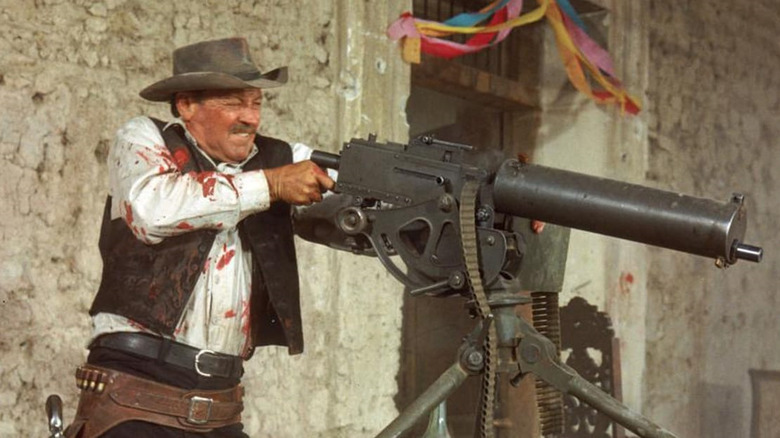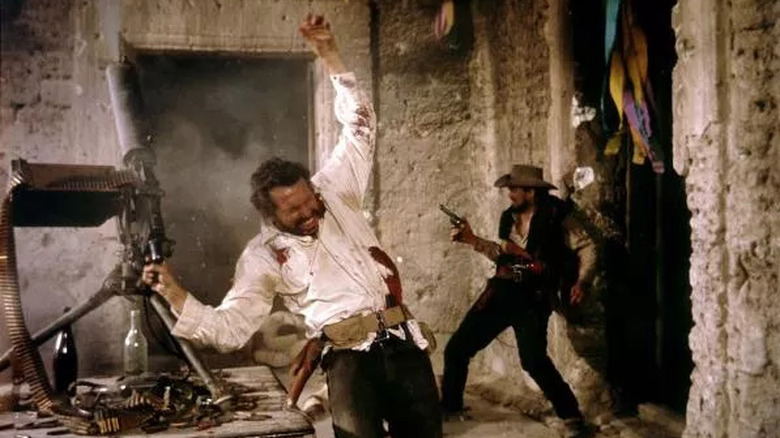The Wild Bunch's Gruesome Finale Was As Brutal To Film As It Is To Watch
In its 145 minute runtime, Sam Peckinpah's elegiac Western "The Wild Bunch" tipped its hat to a bygone era while ushering in a new cinematic one. Near the Mexican-American border, a band of fading outlaws — that's Pike Bishop (William Holden), Dutch Engstrom (Ernest Borgnine), and the brothers Gorch ( Warren Oates and Ben Johnson), a decimation of their former crew — reckon with the shift towards modernity and away from the old days of the West in 1913. What was supposed to be one last score for the aging gang goes sour, but they do not go gentle into that good night.
Upon its release in June of 1969, "The Wild Bunch" was met with praise — and controversy, due to its visceral violence. When asked why the film was necessary in the first place, the "Straw Dogs" director said it plain at a screening (at which a young Roger Ebert was present):
"We wanted to show violence in real terms. Dying is not fun and games. Movies make it look so detached. With 'The Wild Bunch,' people get involved whether they like it or not. They do not have the mild reactions to it."
Peckinpah was doing precisely what Arthur Penn had done with the squib-heavy crime picture "Bonnie and Clyde" two years prior: taking full advantage of the post-Production Code era of loosened restrictions (though the freshly-formed MPAA would soon give the movie hell). The story is bookended and peppered with bouts of vicious, bloody gun violence that spares no civilians, but the sequence that got a bee in everyone's bonnet was the climactic shoot-out dubbed "The Battle of Bloody Porch." In it, the Wild Bunch reach the terminus of their haggard journey and shoot the crooked Mexican Federal Army General Mapache (Emilio Fernandez) and his adviser in a dispute. The collective pause that hangs in the air after the kill is brief but electric, that certain spell of silence in Heaven before the Seventh Seal is opened.
Borgnine lets an incredulous giggle cut the stillness before Pike turns his automatic onto Mapache's Army advisor and pulls the trigger, prompting the Federales to open fire on the quartet. The influential five-minute finale is a storm of bullets and bloodshed, meticulously edited by cutting room maestro Lou Lombardo to make time feel malleable. When the dust has settled and the shells have been expended, the film racks up a body count of 145. As it happens, the Battle of Bloody Porch was a savage symphony to shoot, nearly as harsh on the film crew as it was on its fictional victims.
An assembly line of wardrobe repairs
The Battle of Bloody Porch was a lynchpin for "The Wild Bunch" entire, the culmination of painstaking character development and steady plot-building. W.K. Stratton's incredible BTS account, "The Wild Bunch: Sam Peckinpah, a Revolution in Hollywood, and the Making of a Legendary Film" recounts the stormy storyteller's trials and tribulations in shaping that final sequence. Peckinpah didn't have "a f***ing clue" as to how to shoot the scene; producer Phil Feldman called a meeting to go over the finer details, but even Ernest Borgnine sensed the director's apprehension before the time to shoot the scene arrived.
One afternoon, Borgnine noticed Sam walking with his head low and said, "Sam, you look worried. What's the matter?"
"I'm worried."
"Worried? About what?"
"I don't know—I hesitate about getting into this next thing, you know, with all this . . ." Sam trailed off.
Borgnine reassured his director, but there were indeed plenty of details to go over: three pages worth, according to the script. For the next twelve days, Peckinpah, director of photography Lucien Ballard, and an intrepid crew toiled to bring the battle to terrifying life. Wardrobe supervisor Gordon Dawson rapidly cranked out costumes to meet shooting needs, ending up with around 350 Mexican Army uniforms to stretch into exponentially more onscreen deaths. A Neon Magazine flashback culled from previous interviews with the cast and crew unearthed insights from Gordon Dawson:
"I had a uniform repair factory going on behind the blood hits. They'd come in bloody, ragged, torn. They'd be taped up, painted over the tape, stuck in front of a heater lamp to dry, a guy would go over the patch with dirty gloves to make it look like aged cloth, then they'd get blown up again."
The patches were covering faux blood stains from the 10,000 raw meat-packed squibs used for the production. Peckinpah instructed other stains to be painted black to mimic real dried blood, all to underscore the grim reality of the violence.
'We're all violent people'
Editor Lou Lambardo and associate editor Robert Wolfe had hundreds of thousands of feet of film to get through after the Mexico shoot, but spent a year processing and splicing it all to create what Roger Ebert called, "one of the great defining moments of modern movies." The Battle of Bloody Porch alone squeezed over 300 edits into the five-minute scene, splicing together footage shot from multiple cameras filming at different frame rates – the slow juxtaposed with the quick, not unlike the climax of Michael Mann's "Manhunter," which utilized a similar tapestry of quick cuts, dropped frames, and slow-motion to disorient and act as a meditation on the very violence it depicts. Stratton's book credits Peckinpah with the summation that:
"The point of the film is to take this facade of movie violence and open it up. Get people involved in it so they are starting to go in their Hollywood television predictable reaction syndrome, and then twist it so it's not fun anymore, just a wave of sickness in the gut. It's ugly, brutalizing, and bloody awful; it's not fun and games and cowboys and Indians. It's a terrible, ugly thing, and yet there's a certain response that you get from it, an excitement, because we're all violent people."
"The Wild Bunch" observes just one group of violent people passing the baton to successors who operate their violence differently, a little more coldly. While the bloodshed in the movie was necessary, Peckinpah argues, as one of his wild bunch says in the film, "We gotta start thinking beyond our guns. Those days are closing fast."

